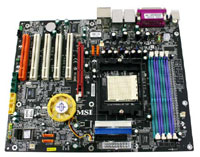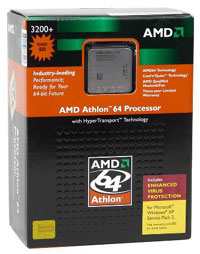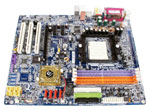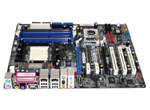Buyer's Guide - Mid-Range, January 2005
by Jarred Walton on January 21, 2005 11:09 AM EST- Posted in
- Guides
AMD Motherboard and CPU Recommendations
We've already covered the basic dilemma with the AMD platform right now: to PCIe or not to PCIe, that is the question. You hopefully know yourself well enough to have made a decision on whether you want to be an early adopter or if you want to trail behind the bleeding edge and take a conservative approach. Our recommendations, incidentally, are made in light of what is actually available right now. We look at several vendor sites as well as our own RealTime Pricing Engine to find out what is currently in stock. That means there are exactly three PCIe boards from which to choose, and two of them are really in the high-end performance market (the SLI boards).
 |
 |
| Click images to enlarge. | |
AMD Platform Recommendation
Motherboard: MSI K8N Neo2 Platinum (NF3 250 Ultra)Price: $139 Shipped
Processor: Athlon 64 3200+ 90nm (Retail)
Price: $215 Shipped
On the conservative approach, we continue to stick with the AGP platform and the nForce3 250 Ultra chipset. The MSI K8N Neo2 Platinum [RTPE: MSI K8N Neo2 Platinum] has worked very well in our testing, and we have several systems using it that are running without any problems. Tweaking and overclocking options are very good if it's something that you're interested in, and you get known reliability and performance with a low chance of any unforeseen bugs in your system. If living on the bleeding edge and potentially troubleshooting your new PC on a regular basis is not your idea of a good time, this is still the most sensible platform. Realistically, this will probably be the last time that we actually recommend this platform, as the new nForce4 motherboards - not to mention alternatives using the ATI Express 200 chipsets and perhaps even some VIA PCIe solutions - should reach the point where we can give them a full recommendation by the time we next run our Mid-Range Guide.
For the processor, we opt for the 90nm Athlon 64 3200+ part [RTPE: ADA3200DIK4B]. It offers plenty of power with a reasonable price. Overclockers will also appreciate the added clockspeed headroom and reduced heat of the 90nm parts, but that's a topic for another Guide. A 3500+ would be nice, but the 90nm parts are too expensive while the 130nm 3500+ has a higher power draw. Our tests showed that the power draw of the 90nm parts is significantly lower than the 130nm parts. So, if you're the one actually paying the electricity bills, the 90nm parts will easily save you money over time, relative to the 130nm parts - particularly if you leave your PC running 24/7.
 |
 |
 |
| Click images to enlarge. | ||
AMD Platform Alternative
Motherboard: Gigabyte GA-K8NF-9 (NF4 4X)Price: $146 Shipped
Motherboard: ASUS A8N SLI Deluxe (NF4 SLI)
Price: $197 Shipped
Processor: Athlon 64 3500+ 90nm (Retail)
Price: $324 Shipped
For those who like to live on the edge, PCI Express boards are finally starting to appear at retail. Finding them in stock, unfortunately, can be difficult, and this affects our recommendation. You'll have to wait for a full review, but our "mid-range" suggestion right now is to pick up the Gigabyte GA-K8NF-9. Newegg has listed the Chaintech VNF4/Ultra [RTPE: Chaintech nForce4 Ultra VNF4] for a couple weeks now, but either they're disappearing so fast that they're almost never in stock, or they may not really be available yet. The Chaintech looks to be the potentially better performer, as it includes the Ultra version of the nForce4 chipset instead of the cheaper 4X version. The difference, if you recall, is that the Ultra has an unlocked HyperTransport multiplier that should offer more in the way of overclocking, while the 4X is supposed to be locked at a 4X HyperTransport multiplier (800 MHz) - at least, it's not validated to run at anything other than 4X. If you're not concerned with official validation, the Gigabyte GA-K8NF-9 [RTPE: Gigabyte nForce4 GA-K8NF-9] is readily available from several sources, and it includes some additional features like IEEE1394b.
If you're really serious about shifting to PCI Express boards right now, a better pick would probably be the ASUS A8N SLI Deluxe [RTPE: ASUS nForce4 A8N-SLI Deluxe], which is available for about $200 now from several locations. Gigabyte and MSI also offer SLI boards, but they're less available and even more expensive than the ASUS. We've talked a lot about the benefits of SLI vs. non-SLI, but let's just say that it's the only option that makes a lot of sense to us at this moment in time. If you really want to make the shift to PCI Express, you might as well get an SLI motherboard at the same time. It's a high-end option, of course, but so are all PCIe graphics cards above the 6600GT.
For the processor on our alternative platform, we've upgraded to the Athlon 64 3500+ processor [RTPE: ADA3500DIK4B]. Spending more for the 3800+ will take us well out of the mid-range price segment, as the 3800+ costs nearly twice as much as the 3500+ - even the 3500+ is rather expensive. We use the 90nm 3500+ as opposed to the 130nm version (which is cheaper at present). With the potential SLI video cards sucking down a lot of power, it can't hurt to cut the processor's power consumption.










46 Comments
View All Comments
JarredWalton - Sunday, January 23, 2005 - link
35 - Damn. Foiled. :) I forget these things over time. Wasn't the original Raptor TCQ and the newer version has something like "TCQ-II" which was supposed to improve on standard TCQ somehow? Anyway, our NCQ article didn't really show a major benefit for desktop use, but I've fixed the error now. Thanks!REMF - Saturday, January 22, 2005 - link
"On the other hand, if improved performance is what you're after, the best two choices are either one of the 16MB cache Maxtor drives or the 74GB Western Digital Raptor [RTPE: WD740GD] with its 10,000 RPM design - both of these also offer NCQ, in case you were wondering."the Raptor offers Tagged Command Queuing, not Native Command Queuing.
JarredWalton - Saturday, January 22, 2005 - link
Regarding post #30 and the NEC 3520A, a reader sent me an email informing me that the 3520A uses a new chipset and thus the 3500A is *not* upgradeable to the 3520A via a BIOS flash. Barring any contradicting views, I'll stick with that.JarredWalton - Saturday, January 22, 2005 - link
31 - our RTPE doesn't currently differentiate between the ST3160023AS and the ST3160827AS, unfortunately. For example, the Newegg listing currently priced at $111.50 + $4.69 shipping is the appropriate NCQ model. In reality, the NCQ doesn't seem to be a big deal for non-server systems (just like RAID), but if it's only a few dollars more why not get it? That was my feeling. There are even a couple listings in the RTPE for the ST3160021AS. Basically, the RTPE bots match items according to size and features, but NCQ doesn't seem to be something they're aware of yet.kamaboko - Saturday, January 22, 2005 - link
you know the saying, "can't please all of the people all of the time". i think that applies here. in any case, i found this guide useful since i'm looking at a near total ground up rebuild--minus dvd burner, audigy 2zs, and monitor.beakerman - Saturday, January 22, 2005 - link
"With the added benefit of Native Command Queuing (NCQ), the Seagate drives continue to impress. The Seagate 160 GB SATA [RTPE: ST3160023AS]"According to Seagate, the ST3160023AS does not feature NCQ. I believe the drive you want is the ST3160827AS, which is actually a few $$ cheaper. Both drives are 160 GB SATA.
JarredWalton - Saturday, January 22, 2005 - link
26 - Sorry, I got the wrong "updated burn speeds" in there. The 3500A is indeed capable of 16X DVD+/-R recording. The difference is that the 3520A can do DVD+RW at 8X and DVD-RW at 6X, while the 3500A is stuck at 4X for both. There's a reasonable chance, of course, that a BIOS flash of the 3500A can turn it into the 3520A. I updated the text with this information.28 - The "alternative" was meant as a closer to high-end option. 50% more for the CPU for 10% more performance is a rather expensive upgrade. The jump to the 3800+ is even worse, coming in at 100% more than the 3500+ for a 9% performance increase. I've updated the text slightly to make this more clear. For overclockers, I definitely wouldn't bother with the added cost of the 3500+.
27 - I did mention the home theater aspect for the speakers (last part of the 5300e paragraph), but we're certainly not going to spec out an entire home audio setup, so there's not much to do other than mention it. Your comment ties into the next point:
29 - 2.1 speakers aren't much cheaper than the 5.1s, and you can always just leave the rear speakers disconnected. Still, you have a point that some people really don't want more speakers. In that case, I'm not sure why they would bother with anything more than 2.0 speakers, though. There *are* great 2.0 and 2.1 speakers out there, but then you're almost better off looking at the home audio equipment instead of PC speakers. I dunno... I suppose the Swans are always an option. Anywat, I modified the text to include 2.0/2.1 speakers and headphones as something to consider, along with home theater audio. I moved this into a separate paragraph to draw more attention to it.
Dranzerk - Saturday, January 22, 2005 - link
One suggestion for next buyers guide, I think all kinds system setups like 2.1 speaker systems, you should offer a 5.1 and 2.1 for each type instead of just 5.1.I know some personally don't like 5.1 sounding speakers, and prefer 2.1 speakers.
The logitech Z3 2.1 fit that bill perfectly, you can find them for under $50 also, and they get great reviews.
Pjotr - Saturday, January 22, 2005 - link
I think you are fooling buyers into a wrongful purchase when it comes to performance. In the AMD "Upgraded" PCIe Athlon 64 System you have gone from 3200+ for $215 to 3500+ for $334. The performance increase from 2.0 to 2.2 GHz is smaller than 10 %, in many applications like games it might even be close to 0.Instead of adding $119 for this 0-10 % performance gain, I think sticking with the 3200+ CPU and changing the graphics card from 6600GT to 6800GT (Leadtek A400) is a MUCH better choise, It will cost you £377 minus $190 = $187. If you want to come down close to the $119 difference don't get an SLI motherboard.
This graphics upgrade will make wonders in anything graphics related compared to a 10 % CPU clock speed upgrade that is seldom noticed in anything.
Caligynemania - Saturday, January 22, 2005 - link
Great article, just one comment. With your reccomendation of speakers and sound card as alternatives, you really should mention that a receiver/speaker combination would probably be most people's best bets. A good receiver will run slightly more than the sound cards you mentioned, but the selection for real speakers is infinitely better than computer speakers.